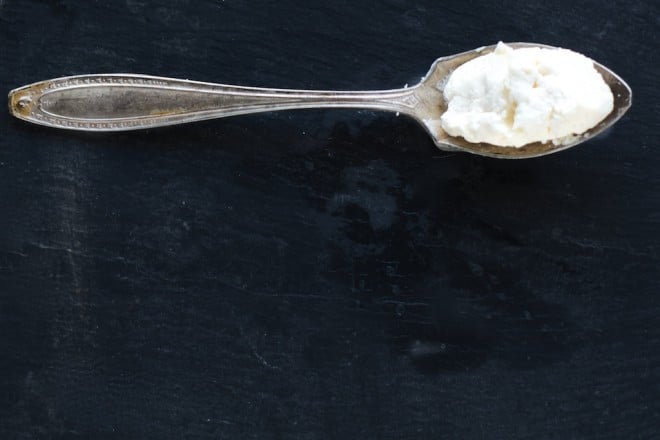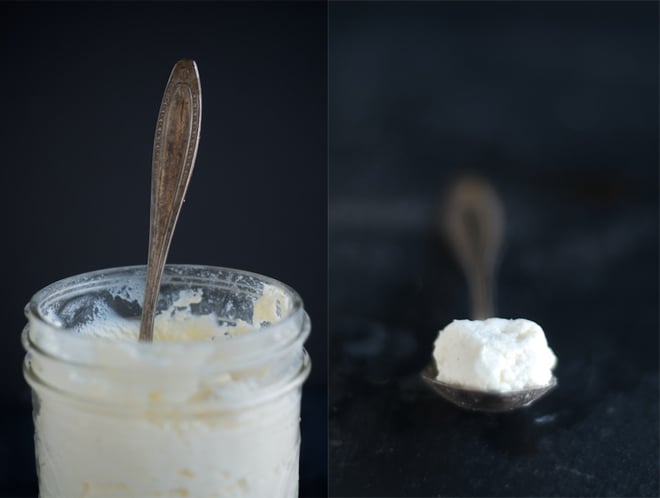How to Make Cream Cheese With Raw Cow's Milk

There's something uniquely special about homemade cheeses - like the making of bone broth, it's often relatively easy but it leads to a deep feeling of accomplishment. I made cheese! You announce to your family. Then you serve to friends and you can't help but say, that cheese - I made that.
Now, I love cheese and have often wondering how to make it. I've delved into home cheese making only a bit: feta, chevre from the raw goat's milk we get each week, yogurt cheese which isn't really much of a cheese at all. For a long time, I've been wondering how to make cream cheese. It couldn't be much harder than a classic chevre, right?
In late spring of this year, I received a sweet little package from Ten Speed Press: Artisan Cheese Making at Home. It's a beautiful little book - one that takes you gradually from simple cheeses and cultured dairy foods like chevre, yogurt, mascarpone and mozzarella to more complex cheeses like cheddar (several versions, actually) and creme fraiche brie.
It's a progressive book in that way - one that guides you from the fundamentals of cheesemaking through your first, simple cheeses to more complex and artisanal cheeses. You move step-by-step and simply. The instructions for each cheese are incredibly detailed and deeply clear - leaving little room for the "guesswork" that leaves you wondering if you're really doing things correctly, but giving you enough knowledge and confidence to step beyond the confines of a single recipe to flavor your cheeses in unique ways once you've mastered the technique.
It's a lovely book, and while it's only been in my possession a few months, it's now worn from use and stained with dripping whey.
Pick up Artisan Cheese Making at Home on Sale
You can pick up a copy of Artisan Cheese Making at Home on Amazon for about $19 (it usually retails for $30), or check out your local independent book store.
A Note about Raw Milk
Many of the recipes inArtisan Cheese Making at Homecall for raw milk or can be adapted for raw milk users, just like Karlin's recipe for how to make cream cheese. In our home, we use raw milk and cream exclusively, and have for more than 5 years. Like many of you, I participate in a herd share which allows my family to purchase part of a herd of dairy cows and share the milk they produce with other herd share members. You can learn more about this system online and look into options in your area from RealMilk.com.
Where to Buy Cheese Making Supplies
To make cream cheese at home, you'll need supplies unique to cheese making, and as this traditional art has fallen from favor in modern kitchens, you're unlikely to be able to purchase them locally unless you live in an area with a particularly vibrant food scene or very well-stocked health food stores.
For this reason, most home cheese makers purchase their supplies (starter cultures, lipase powders, rennet, muslins and forms) online from specialty shops (you can find them here).
Other Notes on this Recipe for Real Cream Cheese
Before you ask: real cream cheese differs from yogurt cheese (labneh) in that it makes use of both a starter culture and rennet as well as salt, which produces a mildly tart and salty cream cheese. It also melts successfully and incorporates into sauces without breaking thanks to the use of rennet.
The original recipe inArtisan Cheese Making at Homealso calls for calcium chloride - a common ingredient in many cheeses. It aids the process of coagulation. I had none, and omitted it in my adaptation below.

Real Cream Cheese
For real cream cheese, you need little more than milk, cream, rennet, starter culture and a bit of sea salt. This recipe is generously adapted from Artisan Cheese Making at Home: Techniques & Recipes for Mastering World-Class Cheeses by Mary Karlin available from Ten Speed Press. You can find the cheese making supplies like mesophilic cheese starter, rennet and muslins online (see sources).
Servings: 1 ½ lbs
Print Save Recipe Saved!
- 1 quart whole milk (preferably raw, not ultrapasteurized)
- 1 quart heavy cream (preferably raw, not ultrapasteurized)
- ¼ teaspoon mesophilic cheese starter
- 3 drops liquid rennet (dissolved into 2 tablespoons filtered water)
- ¾ teaspoon finely ground real salt
-
Pour milk and cream into a large (6-qt) heavy-bottomed stock pot and warm it over low heat until it reaches 75 F - about 15 minutes, then remove it from the heat.
-
Sprinkle starter over the warm milk and let it sit about 5 minutes to rehydrate. Stir the milk and starter together with 20 up and down strokes, then stir in the dilute rennet with 20 up and down strokes. Cover it and allow it to sit at room temperature for up to 12 hours until whey separates from the curds.
-
Line a sieve with butter muslin, pour in the curds and whey then tie up the corners of the muslin to form a bag and hang it from an elevated hook in your kitchen (I use my pot rack or my faucet) over a basin to catch the dripping whey. Allow the curds to hang about 8 hours - discarding the whey or reserving it for another use.
-
Transfer the strained cheese to a large bowl, beat in the salt and form into bricks or spoon into a mason jar and refrigerate. It should keep about 2 to 3 weeks.
How to Make Cream Cheese With Raw Cow's Milk
Source: https://nourishedkitchen.com/how-to-make-cream-cheese/